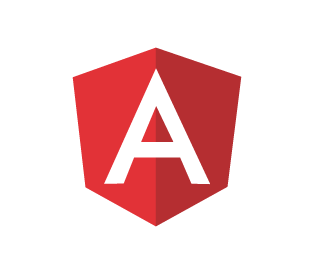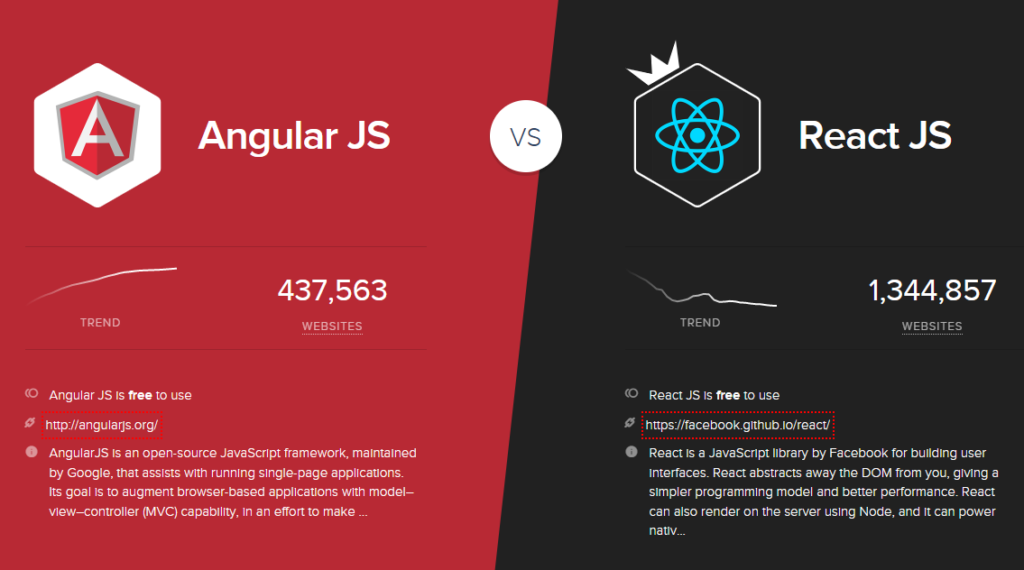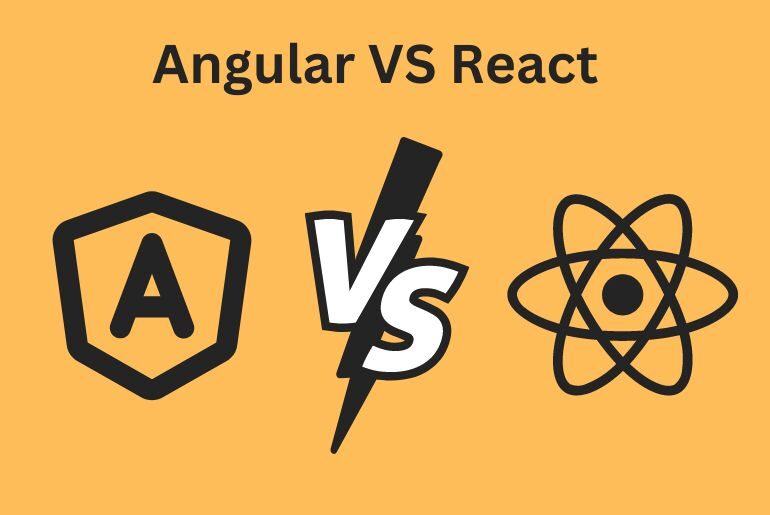React vs Angular -A detailed comparison of the most admired JS Frameworks
Technology is constantly advancing itself to meet the demand and preferences of users. For a long time, websites on the internet have been the primary platform and medium for users to consume information. This inspires industries around the globe to choose to move to a digital platform. Here, the website developers must ensure that the websites they develop meet the current demands and trends.
While developing a website, developers have many options like Angular, Vue, React, and others that can be used to create a top-notch website via JavaScript Framework. However, it has always been a topic of discussion to choose between Angular and React. Both of them have the capabilities to deliver exceptional products. So, what are the factors that shape the decision of a developer while developing a website?
Today, in this blog, we will discuss the factors on which your decision to choose the appropriate framework must be based. Also, we will discuss the core competencies of Angular and React.
What is Angular?

Angular is the JavaScript Framework introduced by Google in 2009 and is currently one of the most famous and sought-after frameworks used by web developers to develop websites. It is an open-source web app development framework mainly managed by Angular Team at Google, including the Angular Community consisting of developers, individuals, agencies, and groups of companies. It is mostly used for building top-notch Single Page Applications using CSS, TypeScript, and HTML. The framework follows the MVC (Model View Controller) structure that helps to divide the task chunks. This capability helps in improving the initial loading time of a webpage.
Benefits of Angular
One of the major reasons behind the popularity of Angular is the support by Google. But, having support from a tech giant might not satisfy the needs of a developer, and thus, an Angular developer can leverage several benefits. The benefits are but are not limited to-
- With Angular, it is easier for the developer to develop a customized Document Model Object (DOM).
- The Angular library has a framework that helps create robust template solutions.
- With Angular, you can develop the pages separately and then combine the components to see the outcomes.
- The developers leverage the benefit of single routing along with the attractive user interface and data binding.
- Developers can build reusable components by directives as it provides support for HTML syntax.
- The inbuilt subsystem dependency of Angular provides significant advantages to the developer.
- Transcript in Angular is very time-saving.
- Coding is more precise and more concise in Angular.
What are the drawbacks of Angular?
As every coin has two faces, there are certain drawbacks to using the Angular framework-
- It is easier to develop DOM; however, some problems regarding the performance of DOM elements can be encountered.
- Learning the Angular framework is comparatively challenging for developers.
- In Angular, third-party integration is slightly hard.
- Limited resources for routing is also one of its drawbacks. or
- Debugging in Angular developed website is challenging.
- Embedding the interactive elements slows down the pages.
What can Angular do that React can’t?
Some core competencies can be leveraged only with the Angular framework. These are-
- Easy Two-Way data binding
- Incredible app structure
- Out-of-the-box full-stack framework
- MVC model
- Dependency Injection
- Incremental DOM
What is React?

Coming to React, was developed by social media giant Facebook in 2013. React is an open-source dynamic JavaScript library that helps create a distinctive user interface. React allows the developers to analyze how the website or app will look and how the users will interact.
Along with building web apps, it is also used for developing native-rendered apps and mobile applications. It also offers reusable library code that saves developers a lot of time and reduces the chances of coding errors. Other than that, virtual DOM and JSX are two of the many features that JavaScript developers leverage the most.
The Benefits of React
- The debugging process is more superficial in React, and developers can reuse the code.
- The complete architecture is based on the component, which can easily be imported.
- React supports a native library that provides efficient and high performance.
- React provides a top-level user interface for development and a better user experience.
- Updates are speedy in front-end as well as server-side support.
- JS extension like syntax and JSX offers HTML quoting that helps render the sub-components.
What Are the Drawbacks of React?
Some of the drawbacks of the React framework are-
- JavaScript extensions like JSX and syntax are comparatively complex and stiff to learn by developers.
- React is more like a library than a framework.
- The release of new tools and documents is too frequent, making it very difficult for the developers to use the framework.
- The architecture of the framework keeps changing.
- Incorporating ReactJS into MVC needs configurations.
What React Does That Angular Doesn’t?
The core competencies of React that cannot be leveraged with Angular are-
- Single Data Binding
- JSX Advantage
- Isomorphic JavaScript
- Building Blocks Flexibility
Usage Statistics of React vs. Angular

Let’s make a short comparison of Reactjs and Angularjs based on usage statistics-
- First of all, you should know that there are around 436,446 websites which are operating on the Angular JS framework. On the other hand, more than 1,344,432 websites are operating on React JS framework (number of websites is still increasing).
- Regarding the top 10k sites on the web, Angular claims 6.35% of the market share, while React claims 5.53%.
- Talking about the top 100k sites, the market share of Angular is 5.086%, while that of React is 3.46%.
- In the top 1M sites, Angular has grabbed the market share of 2.82%, and React has grabbed the share of 2.79%.
- However, when we consider the entire web, the market share of Angular is just 0.62%, while React’s is 1.918%.
- So, Angular is primarily used in leading websites, while React is used more widely.
- Category-wise dominance of React JS and Angular JS is- (columns represent the number of websites)
Key Features of Angularjs and React JS
The difference between angular and react can be understood based on their features. Let’s have a glance at some-
Key Features of Angular
- Syncing steps with current technology
- Built-in support for AJAX, HTTP, and observables
- Time-saving transcript
- More clear and concise coding
- Enhanced error-handling support
- Angular CLI for seamless updates
- Local CSS/ Shadow DOM
- Validation and forms
- Separation of Business Logic and User Interface
Key Features of React
- Leverage to third-party libraries
- Composability and simplicity
- Full support of Facebook
- Time-saving
- Enhanced speed and user experience
- One directional data binding for better code stability
- Rapid development
- Components in React
Angular JS vs. React JS: The Complete Comparison
Now that we have discussed both the framework let’s make the comparison based on major considerations-
UI Component
The user interface is a significant factor in shaping the customer experience. Here, React community leverages its UI tools as a range of free and paid UI components help developers design and deliver an attractive user interface.
Talking Angular consists of a material tech stack with a range of pre-developed components of material designs. This competency of Angular makes UI development much easier and faster for developers.
Componentization
React comes to componentization and has a seamless option that helps build the element trees. Here, the React library provides a functional programming feature where a developer can find the definitions of the declarative component. Moreover, Reacts are structured more logically, and thus they can be read with more ease. It doesn’t require developers to write the code individually.
On the other hand, Angular has a slightly complicated structure based on 3 distinguished layers called Controller, View, and Model. Here, the developer can easily break down the app into different files and thus reuse the templates and elements in numerous parts.
Toolset
With React, the developer can use many code editings tools like Visual Studio, Sublime, and Atom. React uses the “Create React App” tool to bootstrap the project, while Angular.js is used for server-side rendering. For application testing, developers can leverage many tools for different components.
Regarding Angular, it uses different editor tools like Aptana, Visual Studio, and Sublime. Here, “Angular CLI” helps build the project, and “Angular Universal” assists in server-side rendering. The most significant advantage of using Angular is completing testing with a single tool like Jasmine, Karma, or Protractor. It is not possible in React.
Documentation
Documentation in both Angular and React seems to equal each other as both frameworks are getting the updates. However, when specifically talking about Angular, many tutorials and documentation are useless and outdated for the developers. On the other hand, React has better previous versions that the developers can use.
Mobile App Solutions
React provide an entirely native UI experience to assist developers in making their elements and thus bind them to different native codes. The codes can be written in Kotlin, Objective-C, and Java.
Talking about Angular is an Ionic framework that displays the intriguing UI component library and a Cordova Container. So, the app developed with Angular seems more like a web when analyzed from a device.
So, React is better when viewed from a Mobile App perspective.
Productivity and Development Speed
There is a lot of third-party library involvement in React; thus, the speed of development and productivity is highly affected. At the same time, the toolkit in React also varies among the different projects; thus, it takes more time for the developer to handle the project and update the apps.
On the other hand, Angular has a win in case of productivity and development speed. Angular consists of CLI, which helps in building the workplace and thus designing the functioning apps more smoothly. Several tasks become easy with this competency, including creating the elements using the one-line command, fixing complicated issues, and removing the Typescript’s coding feature.
State Handling
Angular follows the NgRx state management process that helps to handle the different states and elements in the app. On the other hand, Angular utilizes Redux for state handling. Here state handling is the action where the different components of the app and user interface are handled to deliver the best user experience.
Popularity
Undoubtedly, React has been the most searched framework by users and developers compared to Angular. React secured 25.12% of the market share in this search, while Angular only claimed 8.4%. So, React beats Angular in terms of popularity. We also discussed the same in previous sections. React is used more in developing the web and app, while leading websites use Angular more.
Freedom and Flexibility
React allows developers to choose the architecture, tools, and libraries for app development. So, it helps to develop the tailored app, which the tech stack is much needed. However, this flexibility can majorly be leveraged by an expert developer.
Coming to React, Angular doesn’t offer such flexibility and freedom to the developer as the selection of tools, architecture, and libraries depends on certain factors.
Testing
Comprehensive testing in Angular can be performed using a single tool. Here the tool can be Protractor, Jasmine, and Karma. So, a lot of time and effort can be saved in Angular in terms of testing.
On the other hand, React doesn’t offer such leverage to the users as different tools are needed for testing the different sets of components in an application.
Data Binding
Angular uses the two-way data binding approach. So, when UI components are altered, the model state is automatically altered. The same happens in the case vice-versa. React uses one-way data binding; thus, UI components are altered after altering the model state. The UI model can not be altered if the developer doesn’t alter the model state.
Angular might seem more straightforward in data binding but React offers a more arranged data overview when handling large-sized projects.
Community Support
As the number of websites developed on React framework is much more than that of Angular, there is a larger community of React developers providing support to React-developed websites compared to that of Angular-developed websites.
React comes clearly with better community support.
App Functionality and User Experience
The newer version of Angular has come up with elements and features like ShadowAPI, which helps to ensure the app’s top-notch functionality and user experience. At the same time, React uses Virtual DOM and Fiber for better App functionality and user experience.
So, both frameworks seem to be giving a tough fight to each other.
Document Object Model (DOM)
Angular uses the Real Document Object Model. It ensures that the data structure is always up-to-date, even if one segment has alterations or changes. Talking about React uses a Virtual Document Object Model, which makes tracking alteration even easier for the developer without affecting the other parts of the tree. Here, Virtual DOM ponders fasters than Real DOM, and thus React is the winner.
Learning Curve
Talking about the learning curve in Angular, the Google Angular IO framework assists with several options that help to solve the different issues. At the same time, it also has a complicated component handling system which can be used only if the developer is familiar with the different concepts and languages such as pipes, RxJS, Typescript, template, etc.
React doesn’t have this huge learning curve as it allows the developer to learn and build the app with React ecosystem quickly. It can work even if the developer is familiar with JavaScript only. At the same time, React also offers other resources that help the beginner to learn and plan app development.
Directives
In Angular, the templates stored with specific Attributes and Angular directives’ syntax are very complex and thus can not be easily understood by budding developers. Coming to React, the templates and logic are revised at the end of every element, which helps to learn the implication of the code without understanding syntax.
Component Architecture
Talking about architecture, both React and Angular have component-based architecture. However, the point of difference is that React uses JavaScript, while Angular uses Typescript for web development. Undoubtedly, Typescript is more compact and error-free to use than that JavaScript. However, Angular, as well as React, carries reusable and cohesive elements.
Ease of Update
Upgrading the app is very easy in Angular due to the availability of enhanced CLI carrying the commands like ng_update. So, updating the apps becomes easy as most of the updating procedure is automatic in Angular.
Talking about React, it carries the capability to move smoothly between the two versions of the app. Here, the front-end development library highly depends on the external library to update the third-party elements.
Languages
Coming to the languages, Angular uses JavaScript or TypeScript. Here both languages are compact; thus, navigating the code and tracing the types becomes much more accessible.
On the other hand, React uses JavaScript ES6+ language. It is integrated with JSX script.
Self-Sufficiency
Angular is more self-sufficient as it is a full-fledged software development framework. So, it doesn’t require any incorporation from any library. All the functions can be executed with Angular Package only.
Talking React needs extra libraries like Helmet, React Router, or Redux. It helps to optimize the tasks like state handling, communicating with API,, and routing.
Use of Libraries
React uses a React Native Library for better and more efficient performance. It helps to develop a user interface with the different usable components of the UI.
On the other hand, Angular consists of many tiny libraries; thus, the documentation process of Angular is longer than that of React.
Installation Time
Considering installation time, React takes longer than Angular to set up. However, once it has been set up, the projects can be delivered fast, and app building also takes a shorter time.
On the other hand, Angular is easier to set up, but coding takes time in Angular. So, project delivery can experience a delay.
Best Feature
Talking about React, it gives the developer complete leverage of freedom to choose between tools, architecture, and libraries to develop the app.
Here, Angular doesn’t offer such flexibility to the developer, thus considered a losing point for Angular.
React versus Angular: Popularity Comparison
Let’s have the comparison between two frameworks based on some popularity-based factors-
Google Trends: Angular versus React
Considering Google Trends to analyze the popularity of both frameworks, it was found that both have their audience base. React has a lot more websites and apps developed all around the world, and thus it surpasses Angular very easily.
But, at the same time, it was identified that top and leading websites are using Angular more widely; thus, Angular has its niche user base.
So, Angular and React have their popularity as per their target audience.
Stack Overflow: React Versus Angular
According to Stack Overflow, Angular is tagged in 275,740 questions worldwide, while React was tagged in 381,948. Undoubtedly, Reacts seem more popular worldwide, as per Stack Overflow. It might give a rough estimation of popularity but cannot be reliable for comparison as the React community is already much larger than Angular.
NPMTrends: Angular vs Reactjs
As per NPMTrends, React has been much more popular than Angular in the last 5 years. Both frameworks have experienced a good spike in the number of downloads; still, React has beaten Angular by a huge margin. As per the latest data of December 2022, React has been downloaded around 9,509,336 times, while Angular has been downloaded only 1,661,979 times worldwide.
https://npmtrends.com/@Angular /core-vs-React
Examples of Popular Apps Built with Angular
Let’s examine the popular apps built with the Angular framework.
Gmail
One of the biggest mail platforms, with billions of users, is built with the Angular framework. Gmail is a single-page app that renders the data on the front end. This core competency enables access to the cached data in an offline regime and thus provides amazing SPA advantages.
Forbes
The go-to website for tonnes of knowledge and information is built with Angular. The website has more than 74 million monthly users in the US only. You can get an idea about the capability of Angular as it supports the website having this vast user base.
Upwork
A platform that provides work to a large community of freelancers and provides a workforce to people seeking professionals is built with Upwork. The platform has more than 14 million user profiles from over 180 countries. The freelancing craze is increasing continuously, and the platform is also expected to witness tremendous growth.
PayPal
PayPal has more than 305 million active users performing billions of transactions. This vast network is entirely based on the Angular framework ensuring efficient performance and handling the load to maintain the top position of the platform. Thanks to Angular, users can observe the features like few-click authorization for individuals and businesses.
Deutsche Bank
One of the leading worldwide venture banks is using Angular for its website. The framework has instilled the features like free branch banking, a facility for senior citizens, SMS and Email alerts, E-Statements, Phone Banking, DB OnlineBanking, etc.
Freelancer
Australian-based freelancing platform, and currently one of the most known freelancing platforms, is also built with Angular. The platform covers more than 247 domains with features like registration, payments, job listing, advanced search, messaging, project management tools, bidding mechanisms, and more.
Examples of Popular Apps Built with React
Now, let’s glance over the different and popular apps built with the React framework.
Facebook Ads Manager
Facebook Ads Manager is one of the very first applications developed by Facebook on React Native. The platform is among the most popular platforms for businesses and individuals to post their ads and manage them. Some of the biggest reasons behind choosing the React platform are its capabilities to handle differences in time zones, date formats, ad formats, and much more.
AirBnB
The well-known and go-to platform for booking hotels and rental properties,s is built on React Native. During the initial stage of the project, integrating the framework with existing native apps was expensive, but at the same time, it was also worth the investment.
Uber Eats
Food delivery services giant “UberEats” is also built on React Native. Remember that this application is different from its standard application, “Uber,”. According to the developers, React Native has delivered a seamless and unforgettable experience designing and building the app’s dashboard.
Netflix
You must have heard the name Netflix. At the same time, you must be aware of the monthly users that the platform entertains. Note that Netflix is also built on the React framework. The framework has replaced DOM in web browsers to enhance the user experience on low-performance of television.
Discord
The go-to platform for gamers to connect with their pals via photos, videos, and messages is built on the React framework. The ReactJS library has helped the developers write 98% of the code to deliver an even more efficient communication experience for the users.
With more than 2 billion monthly users, the platform is among the biggest social media platforms in the world. React Framework supports this platform, ensuring the services and features like Google Maps APIs, search engine accuracy, geolocations, tags without hashtags, and much more.
Angular vs. Reactjs: When to Choose What?
When to Use Angular?
It’s best to use Angular Framework in the following situations-
For Dynamic App
Angular can be the best choice for developing a dynamic web page or app. It allows you to use HTML as a template and markup language. At the same time, you can also use HTML syntax to express the app’s components clearly in data binding. The dependency injection feature of the framework reduces the efforts of the developer to write the codes repeatedly.
Progressive Web Apps
Google introduced PWA in 2015, and Angular developers explored PWA’s potential before any web page frameworks. The built-in support for Progressive Web Apps helps enterprises efficiently manage their PWA development processes.
Enterprise-Grade and High-Scale Apps
Also, if you are looking for a framework for a high-scale app or enterprise-grade app, Angular is most suitable. TypeScript programming language from Microsoft strictly ensures scalability and thus instills the features like navigation, autocompletion, advanced refactoring, and much more.
When to Use React?
It’s best to use React Framework in the following situations-
Website Optimized for SEO
If you are concerned about your website’s SEO and SERP results, it is best to go for React Framework. The server-side rendering capabilities of React are better than that of Angular, and thus, it is far more SEO-friendly.
Static Website
Angular websites are meant to be fast and lightweight. Angular carries a large bundle size making the project more complicated and bigger. So, React is a better choice for developing a Static Website.
Short-term Projects
Short-term projects are budget conscious, coming from start-ups and small companies. The easier learning curve of React makes sure that any developer with basic knowledge of HTML, CSS, or JavaScript can undertake the project and complete it efficiently.
Which Is Better: Angular or React?
Both frameworks have their use cases; thus, both are the developers’ choices per the situation. Undoubtedly, React has a vast user base worldwide as it gets support from a larger developer community. However, to handle large sites, Angular can be a better choice. Virtual DOM in React is also a better implementation factor than that of Angular.
However, the following table might help you find a better framework for your project:
| Measuring parameter | Angular | React |
| Type | Framework | Library |
| Language | TypeScript | JavaScript |
| Company | ||
| Data Binding | Two-way | One-way |
| Architecture | Component-based | Component-based |
| Scalability | Scalable | Scalable |
| DOM | Real DOM | Virtual DOM |
| Compatibility | Need to install updates | Full backward compatibility |
Wrapping UP
React, and Angular are the choices of developers to develop web apps using JavaScript Framework. However, if we have to choose one, the question will be which one to choose, React or Angular. So, different factors define the choice. However, the more significant factor is the size of the project.
For example, if you plan to develop a large app, it would be best to use the Angular framework. Microsoft’s programming language has made the framework more scalable. On the other hand, if your vision is to develop a static app or start a small project with large community support, you can go for React Framework.




